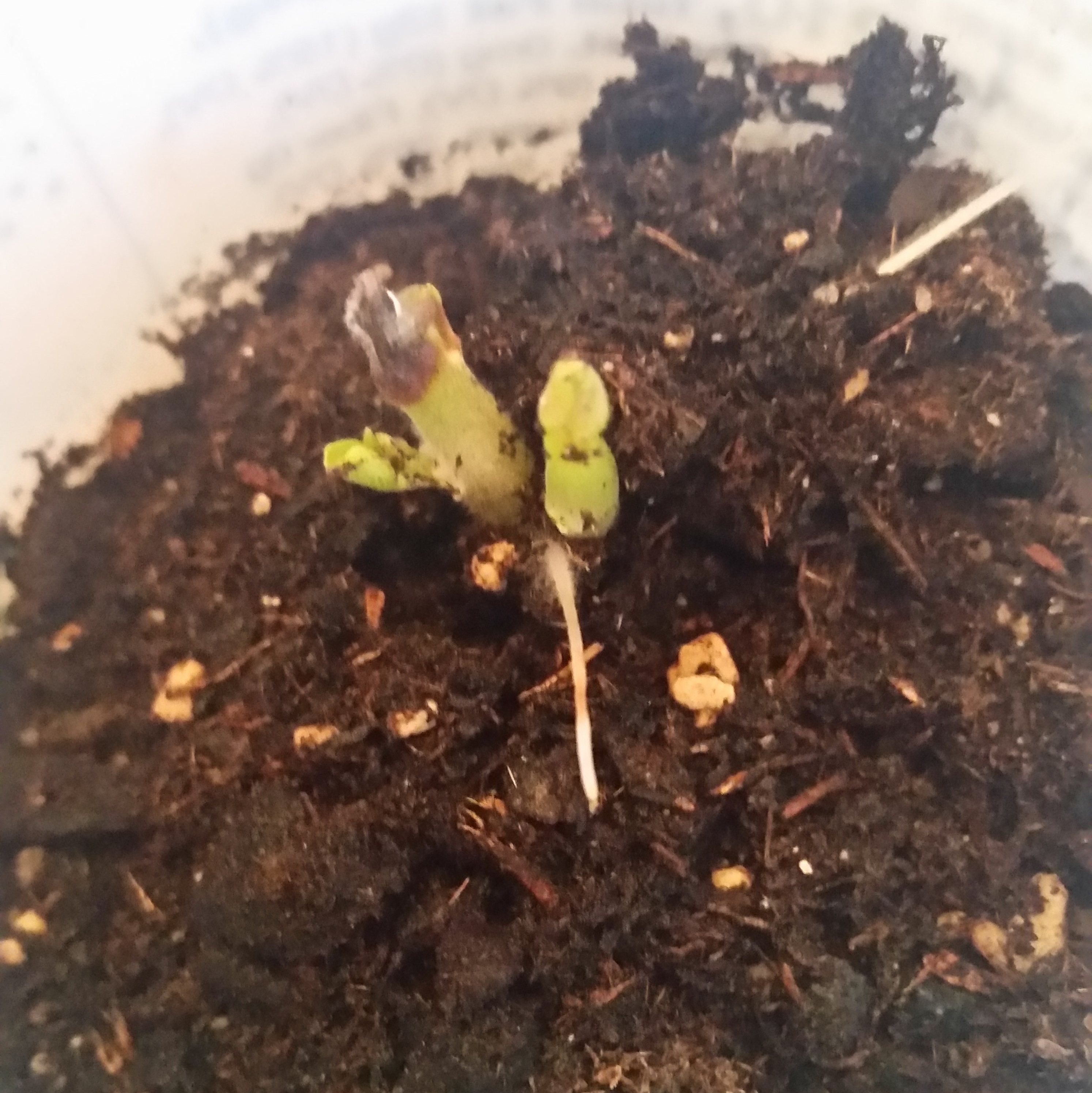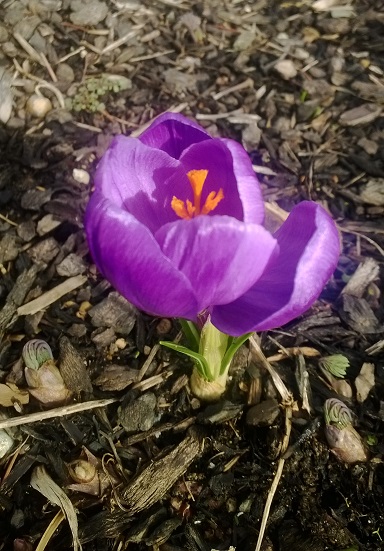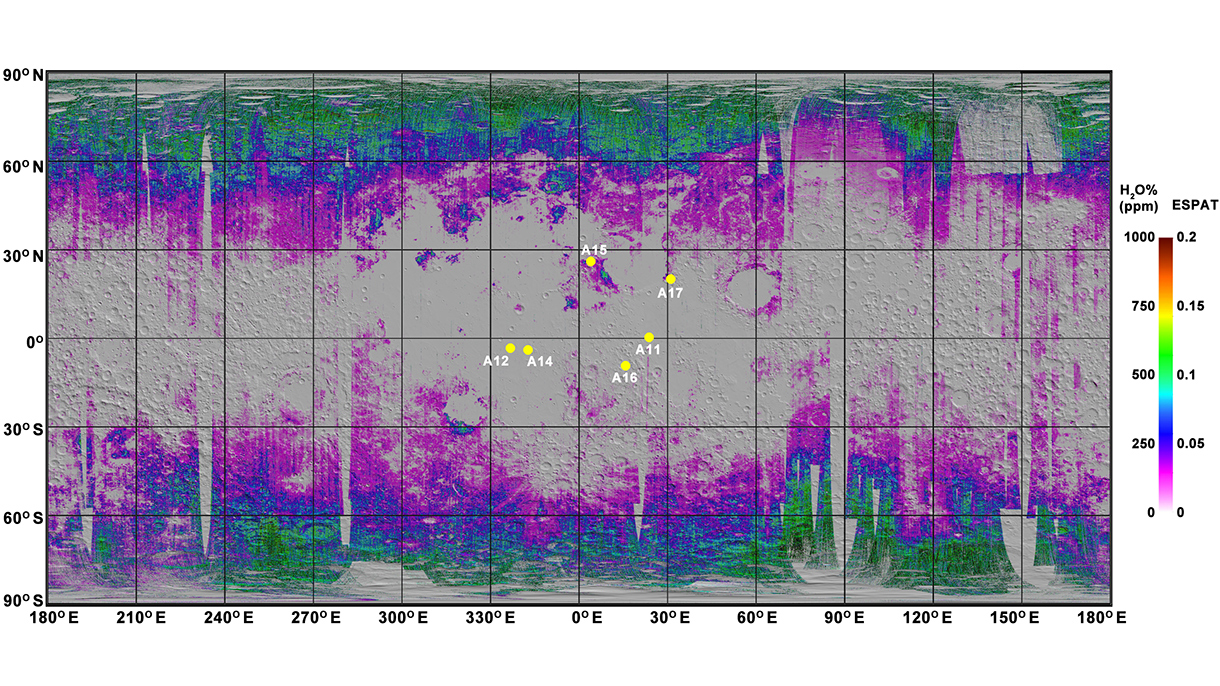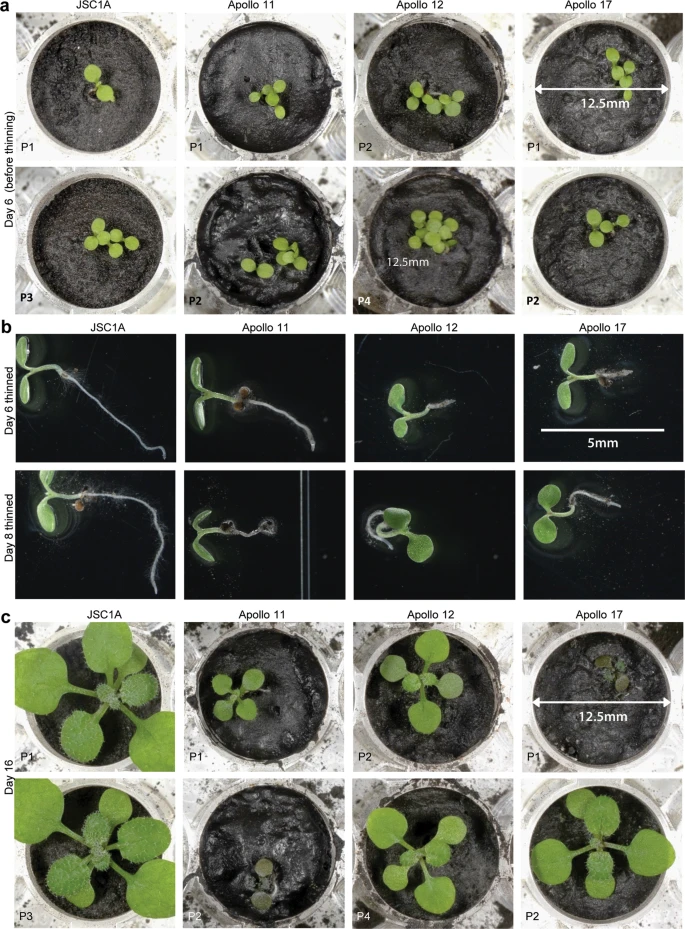Plant Life in the Lunar Environment

Potato sprout
Map of Lunar landings

Crocus Flower
The US Apollo program did not try to take plant life to the Moon's surface, only humans. USSR's Zond program did not try to take plant life to the Moon's surface, only around the Moon. China's Chang'e program did take plant seeds to the Moon's surface in 2019, but used Earth atmosphere, water, and nutrients inside a terrarium not using any local in situ Lunar resources. The Moon would be a very hostile environment to life so the Chang'e 4 spacecraft used an environmentally controlled sealed and insulated container for its biosphere experiment.
There are a number of things plant life needs. Plants need liquid water, an atmosphere with carbon dioxide, sunlight, nutrients, and a few other things to grow. The energy from sunlight is used to chemically change water (H2O) and carbon dioxide (CO2) into sugar. This process is called photosynthesis. The overall chemical equation for the photosynthesis that occurs in plants is:
- 6 CO2 + 6 H2O + light -> C6H12O6 + 6 O2
where:
- the product from photosynthesis is sugar (C6H12O6)
- a waste product from photosynthesis is oxygen (O2)
- carbon dioxide (CO2) is a reactant
- water (H2O) is a reactant
Atmosphere with Carbon Dioxide
Plants require the carbon dioxide from the atmosphere in order to perform photosynthesis. Plants take in carbon dioxide and release oxygen into the atmosphere. With no atmosphere on the Moon, plants would not have access to carbon dioxide. This could be resolved by having the plants in a pressurized domed or underground terrarium that is filled with carbon dioxide. Note that plants do not require the same atmospheric composition or sea level pressure that exists on Earth. Alpine plants grow in atmospheric pressure as low as 1/2 that of sea level pressure. Also, plants were grown on NASA's Skylab space station, and it used an atmosphere of 74% oxygen and only 26% nitrogen at 5 psi or about 1/3 Earth atmospheric pressure. Plants have been shown to be able to survive at pressures as low as 1.5 psi or about 1/10 Earth atmospheric pressure. The carbon dioxide needed for plants could be taken to the Moon. However, while only small amounts, carbon is present in the lunar regolith. It is hypothesised that this carbon could be extracted by heating the lunar regolith, causing carbon monoxide (CO), carbon dioxide (CO2), and methane (CH4) to form. See nutrients below. Also the atmosphere on Earth keeps the environment warm at night and cool during the day since it distributes heat which decreases thermal extremes. More about this under plants need for a temperature range below. Additionally the atmosphere on Earth provides a radiation shield and meteor sheild.
See also:
| Molecule | Earth 1 atm (101.325 kPa) | Earth rank | Lunar 3x10-15 atm (0.3 nPa) | Mars 6x10-3 atm (610 Pa) |
|---|---|---|---|---|
| Nitrogen (N2) | 780,840 | 1 | 0 | 26,000 |
| Oxygen (02) | 209,460 | 2 (plants produce) | 0 | 1,740 |
| Argon (Ar) | 9,340 | 3 | ~600,000 | 19,000 |
| Carbon dioxide (CO2) | 413.32 | 4 (plants use) | 0 | 949,000 |
| Neon (Ne) | 18.18 | 5 | ~200,000 | 0 |
| Helium (He) | 5.24 | 6 | ~200,000 | 0 |
| Methane (CH4) | 1.87 | 7 | 0 | 0 |
| Krypton (Kr) | 1.14 | 8 | 0 | 0 |
Water
Plants require water in order to perform photosynthesis. They also require water both to make nutrients and to move nutrients through their body from the soil. Plants would need water in a liquid state and not solid (ice) nor a gas (water vapor). No water was found on the Moon during the Apollo missions.
The water needed for plants could be taken to the Moon.
However, while the Apollo missions landed near the Lunar equator and found no water, small amounts of water are believed to exist closer to the Lunar poles.
Scientists from Brown University created a
global map of where evidence indicates water exists in lunar regolith
based on data from the Chandrayaan-1 spacecraft.

Lunar water distribution
The water concentrations are less than found in the Earth's driest deserts,
but generally the concentration is greater the closer you get to the lunar poles.
Note that instruments on the Chandrayaan-1, Lunar Reconnaissance Orbiter, and LCROSS spacecraft found evidence of hydroxyl (-OH),
which could be water (H2O) but could also be hydrates or compounds with chemically bound water molecules.
Thus, the form of water on the Moon might be solid water or ice,
but it could also be hydrates in the lunar regolith, or a mix of the two.
See nutrients below.
If water was found on the Moon, it would not be water vapor since water vapor would be lost to space or broken down by sunlight.
It also wouldn't be liquid water since with no atmospheric pressure water sublimes directly from solid to vapor.
The triple point of a substance is where it changes directly from a solid to a gas without becoming a liquid also known as its sublimation point.
Water has a triple point if it is below 0.006 Earth atmospheres of pressure.
Thus, without more than 0.006 of Earth atmospheric pressure, you can't get liquid water.

Phase diagram of water
Maintaining water in a liquid state on the Moon could be resolved by having the plants in a
pressurized domed or underground terrarium
that has an atmosphere.
The freezing point or melting point of water also changes with pressure.
However, the melting point only changes slightly from 0.01 degrees C at 0.006 Earth atmospheres to 0 degrees C at 1 Earth atmosphere.
On the other hand, the boiling point or condensing point of water can change significantly with pressure.
The boiling point changes from 0.01 degrees C at 0.006 Earth atmospheres to approximately 71 degrees C at 0.33 Earth atmospheres, which is the pressure Apollo spacecraft used, to 100 degress C at 1 Earth atmosphere.
Thus, unless water on the Moon stays below 0.01 degress C it would probably turn into a gas and float away.
This is why if water exists on the Moon it is either in locations that are always in shadows, like near the poles, or underground where the Sun won't heat it to boiling.
For more details on the state of water under different pressures and temperatures refer to
water phase diagram.
Temperature
Most plants require a certain temperature range to grow. Temperature signals the plant to grow or to go dormant. Too hot or too cold and the plant will die. With no atmosphere to distribute heat and days and nights that last about 14 Earth days each, the Moon goes from very hot to very cold. The thermal environment around a pressurized Lunar terrarium will consist of direct solar flux from the sun and to a lesser extent the reflected Lunar flux and infrared radiation from the Lunar surface. The solar flux is the amount of power that passes through a given area at a given distance from the sun. The average value at the Earth's and the Moon's distance from the sun is called the Solar Constant, and the value is 1360W/m2. This surface temperature will vary according to time in the Lunar day night cycle and latitude which impacts how much solar flux is hitting the ground. Temperatures vary from approximately -170C (-275 F) at night to around 140C (280 F) in the day. Areas of higher latitude can be more benign, and vary from approximately -60C to -40C, assuming locations near the poles that avoid Lunar night and permanently shadowed craters. However, permanently shadowed craters near the Lunar poles is where water ice is most likely to be found. Anything blocking sunlight from hitting the surface will allow that item to radiate heat rather than absorb more heat. Thus, significant differences in temperature also occur between sunlit areas and areas in shade. Temperatures in permanently shadowed craters near the poles have been estimated at less than -260C. It might be possible to bury the terrarium since one meter below the Lunar surface the temperature doesn't rise or fall as extremely as on the surface. If this were done, then artificial light would need to be provided when direct sunlight isn't available. However, it might be difficult to build such structures in the ground. The Apollo missions were surprised by the difficulty of extracting subsurface samples. While the top layer of the Moons surface was powdery and soft, attempts to drill into the surface and extract subsurface material resulted in seizing of drill tubes which could not be removed and had to be abandoned. They were ultimately successful and that's how data on temperature at depth of the Lunar surface was obtained. However, this indicates that constructing a buried terrarium might require a large spacecraft, lander, and rover in order to dig a hole more than a meter below the surface. Alternatively, it might be possible to setup a shading system to give regular breaks in the direct sunlight during the 14 Earth days of sunlight. The 14 Earth days of night would still be a problem that might be solved with artificial light. It might be possible to use other passive thermal control mechanisms to regulate the temperature. However, it would probably be necessary to use active systems such as heaters or cooling fluids pumped through the terrarium to maintain a reasonable temperature.
Sunlight
Plants require sunlight to perform photosynthesis, in which the plant produces sugars it uses for energy to grow. With days and nights that last about 14 Earth days each, the Moon goes from too long of a time with sunlight to too long of a time without. The partial solution for temperature of having a shading system would also help with too long of a time with sunlight. Too long of a time without sunlight would still be a problem. Artificial light would need to be provided rather than direct sunlight.
Radiation free environment
Plants may need protection from solar and cosmic radiation. On Earth, energetic charged particles are captured in the Van Allen radiation belt which is held in place by Earth's magnetic field, and Earth's Ozone layer, which is a region of Earth's stratosphere, absorbs most of the Sun's ultraviolet (UV) radiation. The Moon has neither of these to stop potentially harmful radiation. The effects of unstopped radiation is that the radiation can heat and break down plant cells from inside. It's similar to temperatures that are two high for the plant to survive.
Nutrients

arabidopsis thaliana sprouts in Lunar regolith from Apollo missions
For plants to access them, nutrients in the soil are typically dissolved into water in the soil. In addition to needing the chemical elements of carbon, hydrogen, and oxygen from atmosphere and water, the most important nutrients plants need from soil are nitrogen, phosphorus, and potassium. Other nutrients that plants need include magnesium, calcium and sulfur. Plants also need such micronutrients as zinc, molybdenum, copper, manganese, cobalt, iron and boron. Apollo and Luna missions indicate that the Moon has different mineral composition than the Earth, which thus might not support plant life. However, experiments on Earth with Lunar soil simulants have shown that some plants can grow in Lunar soil simulants and plants can grow in Lunar regolith . Note that the experiments conducted on Earth with Lunar soil simulant were done with an Earth atmosphere which contains nitrogen. Thus the lack of nitrogen in lunar regolith might still be an issue in growing plants on the Moon which also has no atmosphere and thus no atmospheric nitrogen.
| Element | Earth crust | Earth rank | Lunar highland | Lunar lowland |
|---|---|---|---|---|
| Oxygen (O) | 466,000 | 1 (plants use) | 446,000 | 417,000 |
| Silicon (Si) | 277,000 | 2 | 210,000 | 212,000 |
| Aluminum (Al) | 81,300 | 3 | 133,000 | 69,700 |
| Iron (Fe) | 50,000 | 4 (plants use) | 48,700 | 132,000 |
| Calcium (Ca) | 36,300 | 5 (plants use) | 106,800 | 78,800 |
| Sodium (Na) | 28,300 | 6 | 3,100 | 2,900 |
| Potassium (K) | 25,900 | 7 (plants use) | 800 | 1,100 |
| Magnesium (Mg) | 20,900 | 8 (plants use) | 45,500 | 57,600 |
| Titanium (Ti) | 4,400 | 9 | 3,100 | 31,000 |
| Hydrogen (H) | 1,400 | 10 (plants use) | 56 | 54 |
| Phosphorus (P) | 1,050 | 11 (plants use) | 500 | 660 |
| Manganese (Mn) | 950 | 12 (plants use) | 675 | 1,700 |
| Fluorine (F) | 625 | 13 | ||
| Barium (Ba) | 400 | 14 | ||
| Strontium (Sr) | 375 | 15 | ||
| Sulfur (S) | 260 | 16 (plants use) | ||
| Carbon (C) | 200 | 17 (plants use) | 100 | 100 |
| Zirconium (Zr) | 165 | 18 | ||
| Vanadium (V) | 135 | 19 | ||
| Chlorine (Cl) | 130 | 20 | 17 | 26 |
While the table represents the Lunar crust element composition, the Lunar surface isn't made up of elements, but rather of molecules or minerals. The NASA Apollo program and Soviet Unions Luna program each brought back Lunar surface samples that have provided insight into the Lunar surface composition. Lunar rocks are in many cases made of the same minerals as found on Earth, such as olivine (Mg2+, Fe2+)2SiO4, pyroxene XY(Si,Al)2O6, where X represents calcium, sodium, iron (II) or magnesium and more rarely zinc, manganese or lithium, and Y represents ions of smaller size, such as chromium, aluminium, iron (III), magnesium, cobalt, manganese, scandium, titanium, vanadium or even iron (II), and plagioclase feldspar (KAlSi3O8, NaAlSi3O8, CaAl2Si2O8) (anorthosite rocks). The basalt rocks of the Lunar maria contain higher abundances of olivine and pyroxene, and less plagioclase. They are richer in iron than terrestrial basalt rocks, and also have lower viscosities. Some of them have high abundances of a ferro-titanic oxide called ilmenite. Olivine and pyroxene are typically found in Lunar mantle, whereas plagioclase feldspar is mostly found in Lunar crust. The mineral ilmenite (FeTiO3) is highly abundant in some maria basalt rocks, and a new mineral named armalcolite was first discovered in Lunar samples.
Note that while these minerals include the element Oxygen (O), they do not include Carbon (C) needed to form carbon dioxide (CO2) nor Hydrogen (H) needed to form water (H2O). Carbon was found in samples returned from the Moon, but Hydrogen was only detected later near the Lunar poles by orbiting spacecraft. In order to setup a pressurized plant terrarium on the Moon, it would be helpful to understand the chemical composition of molecules on the Moon that contain Carbon and Hydrogen so that chemical processes could be understood to most efficiently turn these into carbon dioxide and water.
software links
Also, Earth soil contains microorganisms: bacteria, archaea, fungi, even earthworms that decompose organic materials and support chemical changes. Plants get the nitrogen that they need from the soil, where it has typically been fixed by bacteria and archaea as ammonium from either decomposition or from Earth's atmosphere. From here, various microorganisms convert ammonia to other nitrogen compounds that are easier for plants to use. Nitrifying bacteria convert ammonia to nitrites and then nitrates which plants absorb through their roots. These microorganisms would need to be introduced into lunar regolith for plants to be able to get the nutrients they need.
Gravity
Without gravity, the roots of plants might not know which way to grow. The Moon has a mass of 7.342 x 10^22 kg or about 1/80th that of the Earth, and it's gravity is about 1/6th that of Earth generating an acceleration of about 1.62 m/s2 near it's surface. While the Moon has less gravity than the Earth, it has gravity so it's not clear if plants roots growth into the ground would be impacted by this. ISS experiments suggest that Plants Grow Fine Without Gravity and Plant growth strategies are remodeled by spaceflight . Further the Chang'e 4 biosphere experiment did demonstrate that plants would sprout in the 1/6th Earth gravity that the Moon has.
Time
Plants require a regular progression of time with the ideal conditions to grow properly. Most plants require a minimum of 30 days for their growing season so they would need to be supported through night time on the Moon.
See also:
- global map of where evidence indicates water exists in lunar regolith
- Can Plants Grow on Mars and the Moon: A Growth Experiment on Mars and Moon Soil Simulants
- Plant growth strategies are remodeled by spaceflight
- plants can grow in Lunar regolith
- analysis of Nutrient solutions for Arabidopsis thaliana
- MS (Murashige and Skoog) nutrient solution
Text Copyright (C) 2017 - 2023 R. J. Kuhn. Please note that you are not allowed to reproduce or rehost this page without written permission.

